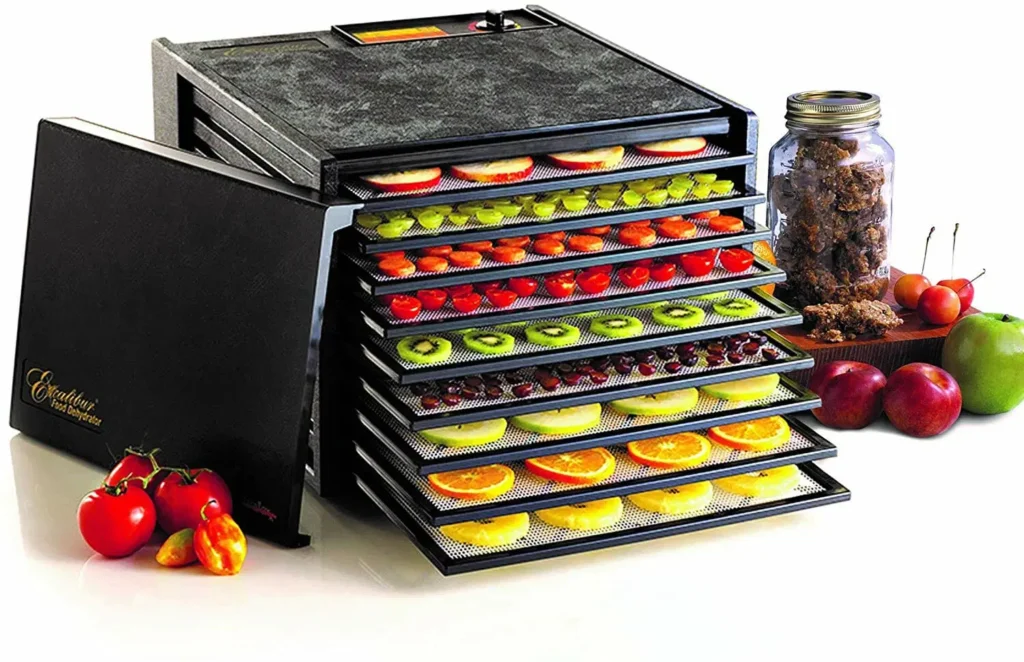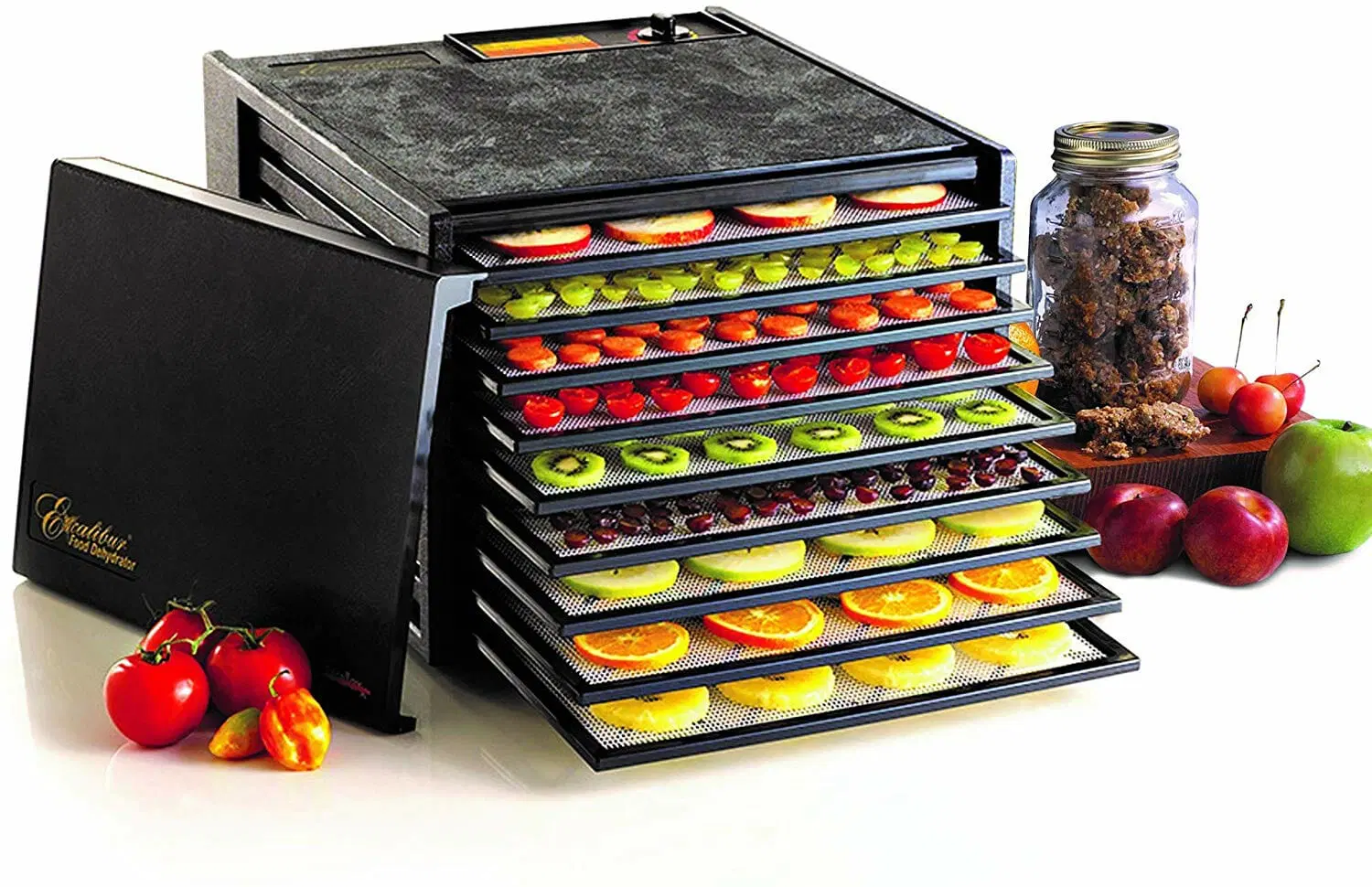Are you looking to revolutionize your diet and make healthier snack choices? Look no further than Food Dehydrator. These handy kitchen appliances have been gaining popularity for their ability to easily create delicious and nutritious snacks. In this blog post, we will explore everything you need to know about Food-Dehydrators, from how they work to the nutritional benefits they offer. Get ready to transform your snacking habits and take control of your health with the power of dehydrators.
What Are Food Dehydrators and How Do They Work?
Food Dehydrators are innovative appliances designed to preserve various foods by eliminating moisture. This process deters the proliferation of bacteria and fungi, the primary causes of food spoilage. Dehydrators circulate warm air around the food, maintaining temperatures from 95 to 160 degrees Fahrenheit. This gentle yet effective method ensures water evaporates while keeping the food’s valuable nutrients intact. The outcome is dried food that’s not only shelf-stable but also retains the original flavours and a significant portion of its nutritional content. Perfect for fruits, vegetables, meats, and more, dehydrators are transforming how we store and enjoy our favourite snacks, making them an indispensable tool for health-conscious individuals and culinary enthusiasts alike.
The Nutritional Benefits of Best Food Dehydrator
Retention of Nutrients:
Best Food Dehydrator are adept at preserving the nutritional content of the food. The drying process is slow and at low heat, which helps retain most of the vitamins and minerals often lost during other cooking methods. This makes dehydrated snacks a healthy option, packed with essential nutrients.
Concentration of Flavours:
As water is removed from the food, the flavours become more concentrated. This not only enhances the taste but also means that a small portion of dehydrated food can satisfy your cravings more effectively than its fresh counterpart. This concentration helps maintain the food’s natural sweetness and intensity of flavours, making it a delicious yet healthy snack option.
Lower Fat Content:
Many dehydrated snacks, particularly fruits and vegetables, contain significantly lower fat content than traditional snacks. This is because the dehydration process eliminates the need for added fats or oils often used in cooking, making them a great choice for anyone monitoring their fat intake.
Fibber Rich:
Dehydrated fruits and vegetables maintain their fibre content throughout dehydration. High-fibre snacks are not only beneficial for digestion but also help in keeping you fuller for longer periods. This makes dehydrated snacks an excellent option for weight management and promoting a healthy digestive system.
Choosing the Right Dehydrator for Your Needs
Given the variety of options available, selecting the perfect Food-Dehydrator can feel overwhelming, but understanding your specific needs can significantly narrow down the choices. Start by considering the capacity that best fits your lifestyle. A dehydrator with a larger capacity and more trays will be ideal for large families or avid gardeners. Conversely, a compact model should suffice for those with limited space or smaller batches of food.
Another critical factor is the temperature range. Look for models that offer a wide range of temperatures to accommodate different types of foods, from herbs that require low temperatures to meats that need higher settings for safe dehydration.
Features such as timers and automatic shut-off can enhance convenience, allowing overnight dehydration without the risk of over-drying. Adjustable shelves offer flexibility for different sizes of food items, making the process more efficient.
Consider the device’s durability and ease of cleaning as well. Dehydrators with dishwasher-safe parts or easy-to-clean surfaces can save time and effort.
Lastly, consider the food types you are most likely to dehydrate. This will guide you toward the features that will be most beneficial for your dehydration projects, ensuring that your investment is tailored precisely to your snacking and preservation goals.
Easy and Delicious Dehydrator Recipes to Get You Started
Diving into food dehydration opens up a treasure trove of culinary possibilities. A simple start can be making fruit leathers, which involves pureeing your favourite fruits and spreading them thinly on a dehydrator tray for a sweet, chewy snack. For those with a savoury palate, kale chips are a must-try; toss kale leaves with olive oil and your choice of seasonings before dehydrating. If you’re a fan of more robust flavours, homemade beef jerky is surprisingly straightforward, requiring only lean cuts of meat marinated in your chosen spices and sauces.
For a crunchy addition to your morning routine, consider crafting your own granola by mixing oats, nuts, seeds, and dried fruit and dehydrating until crispy. Lastly, don’t forget about dried her—– dehydrating fresh herbs from your garden or the market is an excellent way to ensure you always have a supply on hand for elevating your dishes. Each recipe can be customized to suit your taste preferences, encouraging experimentation and creativity in your dehydrated snack creations.
 Tips for Successful Food Dehydration
Tips for Successful Food Dehydration
Attention to detail during the preparation phase is crucial for optimal food dehydration results. Ensure fruits and vegetables are sliced uniformly to promote even drying; this often means aiming for pieces no thicker than ¼ inch. When preparing meats for jerky, trimming any fat and slicing the meat thinly will expedite the drying process and extend the final product’s shelf life. Another key to dehydration success is placing food on the trays; avoid overlapping pieces to allow maximum air circulation. The periodic rotation of trays within the dehydrator is recommended for uniform drying, as the temperature can vary. Be mindful of the drying times and temperatures specific to the food you’re dehydrating, as these can greatly influence the texture and taste of your snacks.
Additionally, investing in a good quality mandoline slicer can be a game-changer for preparing foods to dehydrate, ensuring consistency in thickness. Patience is a virtue in dehydration; rushing the process by increasing the temperature can lead to unevenly dried foods with potentially lower nutritional value. Following these guidelines will enhance your dehydration projects, leading to perfectly dried snacks every time.
The Environmental Advantages
Reduced Food Waste:
Dehydrators allow you to preserve food that might otherwise go to waste. By dehydrating surplus fruits, vegetables, and herbs, you can extend their shelf life and reduce the amount of food thrown away.
Lower Energy Consumption:
Compared to traditional ovens, dehydrators consume significantly less energy for drying foods. This more efficient use of electricity contributes to lower overall energy consumption in the home.
Minimal Packaging Required:
Dehydrated foods require less packaging than their store-bought counterparts. Fewer plastic bags and containers end up in landfills, reducing your overall environmental footprint.
Supports Local and Seasonal Eating:
A dehydrator allows you to fully take advantage of local and seasonal produce by preserving it for later use. This supports local farmers and reduces the carbon emissions associated with transporting food over long distances.
Common Misconceptions about Food Dehydration
A pervasive myth surrounding food dehydration is that it significantly diminishes the food’s nutritional value. While minimal nutrient loss can occur, particularly with some vitamins sensitive to heat, most essential nutrients, including minerals, remain largely unaffected. This misconception likely stems from comparisons with fresh foods without considering the benefits of concentration and preservation that dehydration provides. Additionally, there’s a belief that dehydrated foods are inherently less tasty or satisfying than their fresh or cooked counterparts. However, this overlooks the fact that dehydration intensifies the natural flavours of food, often resulting in a more flavorful and satisfying snack.
Moreover, some think that food dehydration is a time-consuming and labour-intensive process. Still, modern dehydrators are designed for convenience and efficiency, making it easier than ever to create a wide variety of dried foods at home. Lastly, there is the incorrect assumption that dehydrated foods are only suitable for snacks or trail food. In reality, dehydrated ingredients can be rehydrated and used in various recipes, from soups and stews to baked goods, expanding their utility beyond the snack aisle.
How to Incorporate the Best Food-Dehydrator in Your Life?
Incorporating a Food-Dehydrator into your life begins with understanding its vast potential beyond simple snack preparation. Start by experimenting with a variety of foods that you and your family enjoy. For instance, making bulk batches of dehydrated fruits or vegetables during peak seasons can be a cost-effective way to enjoy your favourite produce year-round. Think about integrating dehydrated ingredients into your meals; powdered dehydrated vegetables can add flavour and nutrients to soups, stews, and homemade seasonings.
Organize your dehydrating sessions to coincide with your meal prep days. This way, you can efficiently manage your time and ensure you always have healthy options. Consider dedicating a small space in your kitchen or pantry for your dehydrator and storing your dehydrated goods. This will make the process feel like a regular part of your kitchen routine rather than an occasional activity.
A dehydrator can be invaluable for those interested in gardening or buying in bulk from local farmers’ markets. It allows you to preserve your harvest or market finds, minimize waste, and maximize your investment in local and seasonal produce.
Engage with online communities or local groups dedicated to food dehydration for inspiration and support. Sharing recipes and tips with others can provide new ideas and motivate you to make the most of your dehydrator. By viewing your Food-Dehydrator as a versatile tool in your culinary arsenal, you’ll find countless ways to incorporate its use into your daily routines, enhancing your diet and your lifestyle.
Conclusion
Embracing a Food Dehydrator in your kitchen opens a new chapter in your culinary journey, allowing for the creation of snacks that are not only tasty but also nutrient-rich. The ability to transform a wide range of ingredients into long-lasting, convenient treats brings a sense of accomplishment and fosters a healthier lifestyle. A Food-Dehydrator is invaluable if you aim to make better snack choices, reduce your environmental footprint, or explore new flavours and textures. By experimenting with different recipes and leveraging the benefits of dehydrated foods, you can elevate your diet and enjoy the satisfaction of homemade snacks tailored to your preferences.
FAQs
How long does it take to Food Dehydrator?
The time required to Food Dehydrator can vary widely depending on the type of food, its water content, and the temperature setting of the dehydrator. Fruits and vegetables typically take 8 to 12 hours, while meats can take up to 24 hours. It’s crucial to consult your dehydrator’s manual for specific guidelines and to achieve the desired dryness.
Can I dehydrate different foods at the same time?
You can dehydrate different foods simultaneously, provided they have similar drying times and temperatures. However, to avoid flavour transfer and ensure even drying, it’s advisable to separate strongly scented items or to dehydrate similar food groups together (such as fruits with fruits and vegetables with vegetables).
Do I need to pre-treat foods before dehydrating?
Pre-treating certain foods can enhance colour, flavour, and shelf-life. Fruits like apples and bananas may benefit from a lemon juice dip to prevent browning. Vegetables like potatoes and carrots often require blanching. Meats for jerky should be marinated for flavour and safety. However, pre-treatment is not mandatory for all foods, and preferences may vary.
| Other Good Articles to Read |
| skank blogs |
| unreal blogs |
| tba blogs |
| all city forums |
| dany blogs |
| refuge blogs |
| the music blogs |
| key forums |
| the big blog theory |
| joe blogs |
| blogs 4 me |
| Blogs Emon |
| Related Business Listings |
| Contact Directory |
| Local Business Profiles |



